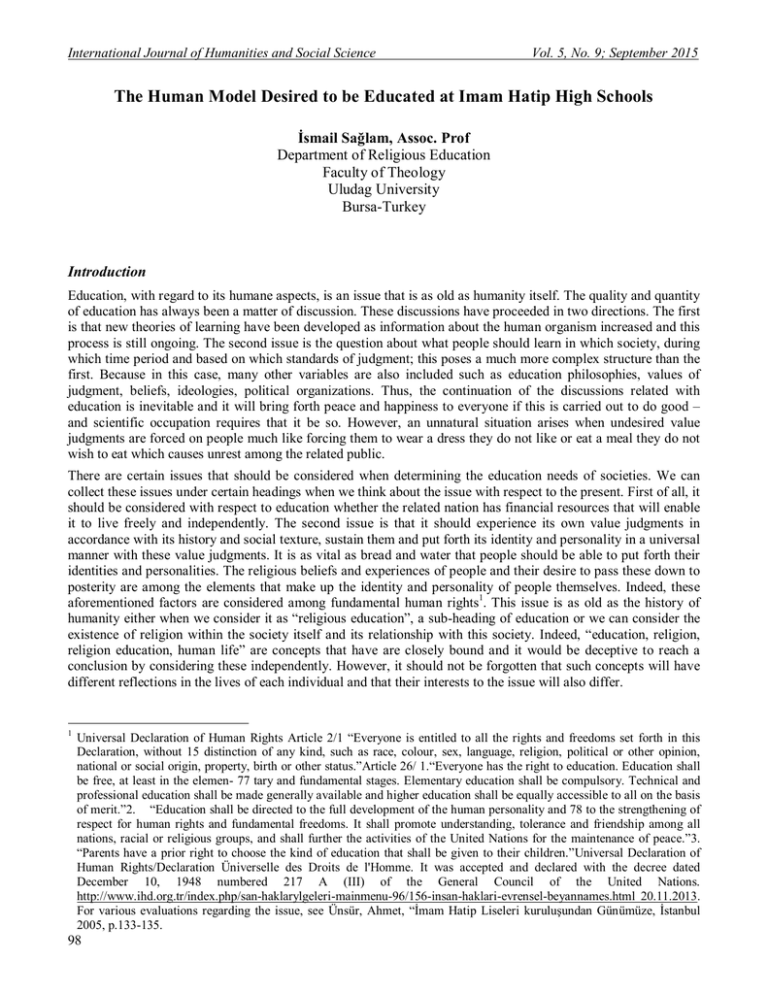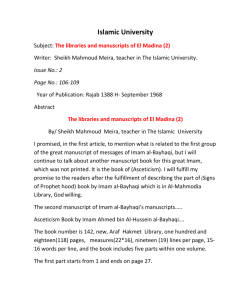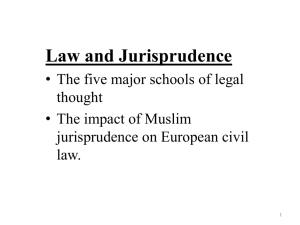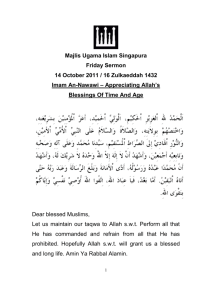The Human Model Desired to be Educated at Imam Hatip... İsmail Sağlam, Assoc. Prof Department of Religious Education
advertisement

International Journal of Humanities and Social Science Vol. 5, No. 9; September 2015 The Human Model Desired to be Educated at Imam Hatip High Schools İsmail Sağlam, Assoc. Prof Department of Religious Education Faculty of Theology Uludag University Bursa-Turkey Introduction Education, with regard to its humane aspects, is an issue that is as old as humanity itself. The quality and quantity of education has always been a matter of discussion. These discussions have proceeded in two directions. The first is that new theories of learning have been developed as information about the human organism increased and this process is still ongoing. The second issue is the question about what people should learn in which society, during which time period and based on which standards of judgment; this poses a much more complex structure than the first. Because in this case, many other variables are also included such as education philosophies, values of judgment, beliefs, ideologies, political organizations. Thus, the continuation of the discussions related with education is inevitable and it will bring forth peace and happiness to everyone if this is carried out to do good – and scientific occupation requires that it be so. However, an unnatural situation arises when undesired value judgments are forced on people much like forcing them to wear a dress they do not like or eat a meal they do not wish to eat which causes unrest among the related public. There are certain issues that should be considered when determining the education needs of societies. We can collect these issues under certain headings when we think about the issue with respect to the present. First of all, it should be considered with respect to education whether the related nation has financial resources that will enable it to live freely and independently. The second issue is that it should experience its own value judgments in accordance with its history and social texture, sustain them and put forth its identity and personality in a universal manner with these value judgments. It is as vital as bread and water that people should be able to put forth their identities and personalities. The religious beliefs and experiences of people and their desire to pass these down to posterity are among the elements that make up the identity and personality of people themselves. Indeed, these aforementioned factors are considered among fundamental human rights1. This issue is as old as the history of humanity either when we consider it as “religious education”, a sub-heading of education or we can consider the existence of religion within the society itself and its relationship with this society. Indeed, “education, religion, religion education, human life” are concepts that have are closely bound and it would be deceptive to reach a conclusion by considering these independently. However, it should not be forgotten that such concepts will have different reflections in the lives of each individual and that their interests to the issue will also differ. 1 Universal Declaration of Human Rights Article 2/1 “Everyone is entitled to all the rights and freedoms set forth in this Declaration, without 15 distinction of any kind, such as race, colour, sex, language, religion, political or other opinion, national or social origin, property, birth or other status.”Article 26/ 1.“Everyone has the right to education. Education shall be free, at least in the elemen- 77 tary and fundamental stages. Elementary education shall be compulsory. Technical and professional education shall be made generally available and higher education shall be equally accessible to all on the basis of merit.”2. “Education shall be directed to the full development of the human personality and 78 to the strengthening of respect for human rights and fundamental freedoms. It shall promote understanding, tolerance and friendship among all nations, racial or religious groups, and shall further the activities of the United Nations for the maintenance of peace.”3. “Parents have a prior right to choose the kind of education that shall be given to their children.”Universal Declaration of Human Rights/Declaration Üniverselle des Droits de l'Homme. It was accepted and declared with the decree dated December 10, 1948 numbered 217 A (III) of the General Council of the United Nations. http://www.ihd.org.tr/index.php/san-haklarylgeleri-mainmenu-96/156-insan-haklari-evrensel-beyannames.html 20.11.2013. For various evaluations regarding the issue, see Ünsür, Ahmet, “İmam Hatip Liseleri kuruluşundan Günümüze, İstanbul 2005, p.133-135. 98 ISSN 2220-8488 (Print), 2221-0989 (Online) ©Center for Promoting Ideas, USA www.ijhssnet.com In this case, our objective is to determine the human model that is tried to be educated at the Imam Hatip High Schools which are secondary education institutions that provide religion education in the Turkish Republic. Imam Hatip High Schools have emerged within this state and in accordance with the legal mechanism of this state and continues their existence. In this case, we can think that there should be a role model in accordance with the state mechanism that these schools try to educate. We will first consider this issue. Secondly, we can talk about the human model that is expected by the public and the Muslim intellectuals that played a role in the emergence of these high schools. Finally, we will try to indicate what we can expect in a general sense from these schools as secondary education religious education institutions within the expectations from Islamic education. 1. The Human Model to be Educated by Imam Hatip High Schools Desired by the State What we mean by state is the will that is declared in constitutions, laws, state programs, development plans and National Education Councils since the establishment of the Republic of Turkey. We need to examine the aforementioned laws, programs, plans and councils in order to understand the human model that this will wishes to educate at the Imam Hatip High Schools. In general, we can summarize the findings as follows when we consider only the discourses related with the human model that should be educated at the Imam Hatip High Schools setting aside the parts that allow religious education in the general sense and give judgments related with where and how such an education will be carried out. - As can be understood from the decree in the 4th Item of the Law of Unification of Education that went into effect as the law numbered 430 published in the Official Gazette dated March 6, 1924 after being accepted at the Grand National Assembly of Turkey on March 3, 1924, “The Board of Education will establish a Faculty of Theology as part of Dâru’l-Fünûn (Ottoman University) as well as separate schools for the education of government officers responsible from the religious duties such as imamate and oration”, what is expected from Imam Hatip High schools is that “people who will be able to carry out religious services such as imams” should be educated2. - Whereas expectations from the students who participated in the 10 month imam hatip course that was asked to be opened with the decree number 247 of the Ministry of Education dated December 30, 1948 and which was planned to start its education services in February 19493were as follows; “… to educate employees who will provide religious services for the whole country …”. - The human model that was desired to be educated at the “Imam Hatip High School” that was opened in October 13, 1951 as part of the Private Schools Directorate with the decree of the Commission of Directors numbered 601 was declared by the Minister of Education at the time Tevfik İleri as follows; “We all agree on the necessity of establishing Imam Hatip High Schools. Because we wish to ensure that mature and cultured imams and religious officials are brought up who will address the Turkish Nation”4. - The following statements can be found in the introduction section of the Imam Hatip Schools Administrative Regulations that went into effect in 19725 “… the objectives of imam Hatip schools according to the decrees of Item 22 of the Law number 633 related with the Establishment and Responsibilities of the Directorate of Religious Affairs dated 22/6/1965 are; educating religious officials to carry out imamate and oratory services, Qur’an course teaching as well as working as a mufti or preacher if necessary.”6 Qur’an course teaching as well as working as a mufti or preacher is also added to the previous expectations of working as an imam and orator. - The following statement can be found in the 32nd item of the 1739 numbered Basic Law on National Education that went into effect in 1973; “İmam Hatip High Schools are secondary school institutions established by the Ministry of National Education where education programs that are preparatory for higher education are provided in addition to educating officials for providing religious services such as working as an imam, preacher or Qur’an course teacher.”7With this law, Imam Hatip High Schools were expected to educate people who can pass on to higher education and thus receive a university degree after completing the education related with religious services. 2 3 4 5 6 7 Resmi Ceride, Date: 6/3/1340, Issue 63. Grand National Assembly of Turkey MinutesMagazine, c. Xıv, p. 106. Cumhuriyet Newspaper, January 3, 1951. Öcal, Mustafa, Osmanlı’dan Günümüze Türkiye’de Din Eğitimi, Düşünce Kitabevi Yayınları, İstanbul 2011, s.189. MEB Magazine of Articles, May 22, 1972, issue 1699, p. 175. Official Gazette, Date 1983, issue: 18081. 99 International Journal of Humanities and Social Science Vol. 5, No. 9; September 2015 - The following expectations are declared regarding Imam Hatip High Schools in addition to the aforementioned goals: “The duties of Imam Hatip High Schools during education activities are to provide education to students in order to ensure that they; a) Are devoted to the order of the constitution, have adopted to the goals of the Turkish National education and are ready to apply them, b) Carry out and live the requirements of national morals and alert against the acts that are harmful for our national structure, c) Are enlightened individuals who believe in and abide by the religious and ethical requirements, d) Have gained a scientific approach and understanding while learning to use their knowledge in their occupations, e) Are hard-working individuals who are ready to work everywhere in our country, f) Contribute to their environment culturally, economically and socially to ensure the development of their society, g) Can be given as examples with their lives and environments, h) Have learned all the skills, knowledge and culture put forth by the program, i) Become reliable professionals with healthy minds and bodies who love and understand people and have the mind and sense of instructors.8 The special goals stated above are naturally very detailed and put forth the gains with regard to morals and values that students who will be educated at these schools gain in addition to gaining information and skills. In short, the human model that the State wants to educate at the Imam Hatip High Schools can be stated as follows: “To educate a person who can take on roles at every level of religious services, is mature, cultured and meets the requirements of religion and ethics while also believing in them, is devoted to his profession, ready to serve at every location in the country, contributes to the cultural, social and economical development of the society, loves and understands people, is reliable as well as an education professional who is strong both physically and character wise and who is ready to receive higher education.” According to the emerging definition, we can state that quite satisfactory results will be gained if we do not look at the issue ideologically but approach it in a scientific manner within a legal framework based on laws. However, unfortunately we witness the fact that Imam Hatip High Schools have experienced strong mentality problems within the course of history. While an ideology tries all in its power to render these schools ineffective using the same legal resources, another ideology can strive to ensure that these schools take part in the educational program of the country. Thus, the fundamental issue here is considering the desires and needs of the public or not. Yet, such harsh reactions and oppositions would not have occurred regarding these schools and the religious courses if only the decree in the Universal Declaration of Human Rights stating that, “Parents have a prior right to choose the kind of education that shall be given to their children (Article 26/3)” was taken into consideration. 2. The Human Model to be Educated by Imam Hatip High Schools Desired by the Public and the Imam Hatip Circles Undoubtedly, the fundamental need of the public is to find the official who will carry out the religious practices such as burial, reciting the azan, performing the prayers as well as carrying out the Friday and religious holiday services. Thus, the human model desired to be educated at these schools is one who will be able to carry out these services. This issue was brought forward by Hamdullah Suphi Tanrıöverduring the Seventh General Assembly of CHP; “... Today we have forty thousand villages, I imagine one mosque in each village, this makes forty thousand mosques; I think about the towns and cities, there should be at least ten thousand mosques. In total this makes fifty thousand. Now if we think of this issue as plainly as this, we need imams and orators who will work at these mosques… When I brought this issue up at the Grand National Assembly of Turkey, the orderlies working there came up to me in tears and said, “I swear that we only have one imam left in six villages. We have the dead wait 8 MEGSB Religion Education General Management, İmam Hatip High Schools Curriculum, Ankara 1985, p. 11-12. 100 ISSN 2220-8488 (Print), 2221-0989 (Online) ©Center for Promoting Ideas, USA www.ijhssnet.com in turns. The imams go from village to village and change villages every day. If you do not give us the imams we need, we will bury our dead like dogs.”9 Whereas Hasan Saka who talked at the group meeting as the President said these words addressing the Minister of National Education, “Tahsin Banguoğlu, you will do what the people want! You will accept religion courses at schools! You will open Imam Hatip and Theology faculties! You will act in accordance with the will of the people! Yes, dear Tahsin Banguoğlu, you will do all these whether you want it or not!...”10thus stating the desire of the people who ask for Imam Hatip graduates who are educated in theological matters such as Qur’an, Hadiths and Islamic Law. Of course, the expectations of the public should not be limited with a certain type of personality that will only serve them in providing various religious practices. This demand actually comes out as a scream that puts forth the urgency of this requirement. The public wants Imam Hatip schools to educate a human model that will “help the nation to be saved from the religious indigence and wretchedness”. 11 This demand points out the goal of fixing the damage that has occurred in the religion of the society and to rebuild religious life with the power of knowledge. We can summarize the human model desired by the public to be educated by the Imam Hatip high schools as follows: “Educating people who will show that a religious way of life can be lived in each area of life by acquiring an advanced level of knowledge who will unite with the public to revive religious life and pass it down to posterity.” Thanks to the opening of Imam Hatip schools, the public has finally had the chance to open a door through which these demands can be met and to support it. This incredible complaisance is the result of the existence of the base of thoughts and values carried over to our day from the age of the Prophet via a rich historical experience as well as its manifestation. These schools have sprang forth from the belief and values of our nation just like pressurized water that springs forth when released. The intellectuals of the Imam Hatip circles also have various expectations in addition to the pure and innocent demands and actions of the public. We can understand the type of people they wish to educate at these schools through the writing of people who have strived and toiled so that these schools can be opened and can continue to survive. It would be wise to mention the thoughts of Mahmut Celalettin Ökten (Celal Hoca) (1882-1961) who is a symbol name within the Imam Hatip circles as well as state his understanding of religion and life. His various opinions can be summarized as follows: “Morality which is given utmost importance in the Qur’an has been closed off within the narrow circles of various classical rules in the East and thus the ideal for humanity has been destroyed. This community does not have an understanding of morality above their waists. Morality is the morality of Mohammad. What should be done is to put forth the principles of this morality and then put them into effect within the family, nation and humanity just like it has been done by the Westerners.”12 “It is obligatory that each and every Muslim should be conscious of the issues of our age and seek to solve them… Religious authorities have very important responsibilities. The load they carry is as heavy as mountains in this day and age. Because the conditions for jihad of the past and the war of today have changed drastically. It should be proven via logical principles which provide a means of expression in our day that religion is the only savior for us amidst the vortexes in which philosophical doctrines are lost.”13 According to Nurettin Topçu, Celal Hoca; “ is a thinker who had the capability to carry out the reforms needed to carry the religion of Islam to a level at which it could ensure the survival of the society of the twentieth century if all the financial means required were provided to him.” The ideas of Celal Hoca have been summarized above and he expresses the human model that he wants to educate at the Imam Hatip schools as follows: “I want to educate religion scholars who know the sciences of the century in which we live in addition to being well versed in the East and the West, who are complaisant but uncompromising… Those who are educated at these schools should receive a good education in philosophy, sociology, psychology, physics, chemistry and mathematics in addition to theology.” We also understand from the statements by Celal Hoca that there are people who are against this human model proposed by him. Two different communities are mentioned here; one is the “unbelievers” and the other is “pear heads”. 9 For more information, see Ayhan Halis, Türkiye’de Din Eğitimi, İstanbul 1999, s.149-150. Ayhan, Halis, Türkiye’de Din Eğitimi, İstanbul 1999, s. 115. 11 For more information see Öcal, Mustafa, İmam Hatip Liseleri ve İlköğretim Okulları, , İstanbul 1994, 53. 12 Yorulmaz, Hüseyin, Bir Neslin Öncüsü Celal Hoca, İstanbul 2011, p. 131-132. 13 Yorulmaz, Hüseyin, Bir Neslin Öncüsü Celal Hoca, İstanbul 2011, p. 135. 10 101 International Journal of Humanities and Social Science Vol. 5, No. 9; September 2015 Those in the first category are the bureaucrats of the day who oppose the teaching of religious sciences at schools and those in the second are the mullahs of the day who find it meaningless to teach social and physical sciences at schools.14 Hayrettin Karaman Hoca is another symbol name within the Imam Hatip circles who is still with us and it would be beneficial to take a look at his expectations in order to understand the human model to be educated at these schools desired by Hayrettin Karaman Hoca: “Ensar (people from Medine who helped the immigration of Muslims) should plan and program the Islamic service in the country by way of using the Imam Hatip schools and its alumnae and should put forth its activities at the proper time again using this human resource; maybe then, through various trials and tribulations it will be able to reach the goal that we live for and which is put forth by Allah as binding duties such as prayer and fasting. Services should be provided by way of education so that this nation is Islamized with all its individuals and as a society.”15 “What we are saying is that, the best community in this day and age to accomplish this (that is to make our people more Islamized) is the Imam-hatip community. And its sources have not dried out yet, I mean there are İmam-Hatip schools and there are people who graduate from these schools. We have all these, but this community has not yet been able to put forth a Muslim individual that they can provide to our age for this nation, nor a model for a Muslim society.”16 Based on the aforementioned quotations as well as other opinions stated in different resources, the opinions of Hayrettin Karaman Hoca regarding the human model that should be educated at Imam Hatip schools can be summarized as below: “The education of a model generation that understands religion and the world, lives by these rules, takes action with the priority to reach the common goal of Islamization of Turkey and the Turkish people who can behave as exemplary individuals to put forth such a society.” 3. The Human Model to be Educated by Imam Hatip High Schools According to the Goals of Islamic Education In order to understand what the human model to be educated by Imam Hatip schools according to the goals of Islamic education is, we should first understand the goal of Islamic education. This target has been defined as follows during the First World Conference on Muslim Education: “Education should target the balanced growth and development of the complete personality of an individual along with the discipline of the soul, mind and emotions of that individual. Accordingly, education should provide the individual all kinds of nutrients required in order to ensure that the individual grows and develops in all aspects be it either mental, physical, scientific or linguistic areas or in a collective manner. It should direct the person to what is best in all these aforementioned fields. The ultimate goal of Islamic education lies under the accomplishment of the complete submission of an individual both socially and as humanity in the broadest sense to Allah.”17 Whereas Muhammed Abdullah Dirâz (1894-1958) expresses Islamic education in more detail as follows: “Perfect humane education includes all abilities and tendencies of humans. The development of the body and the preservation of its health is education of the body; the strengthening of linguistic skills and oration is literary education; the education of the human mind to strengthen one’s ideas and judgments is intellectual education; the nourishment of an individual with correct and beneficial knowledge is scientific education; the teaching of how to make one’s living is vocational education; the awakening of the consciousness with regard to the beauties of the universe and aiding the individual to express these is artistic education; the teaching of the rights of a society as well as the valid laws and regulations is social and country education; development of the horizon of an individual with consciousness of universal brotherhood is humane education; moving constantly towards what is right and thus establishing good and well rooted habits is moral education, taking one step with the soul and reaching higher grounds is religious education”. 18 Islamic education is shaped around the belief principles of the Islamic religion. A collaborative thinking process is ensued regarding the concepts of mankind, universe and Allah which continues as the activity of trying to understand, grasp and insight on the link between these. The most distinctive character of this education is that it starts off by considering Allah. The scientific activity carried out is nothing more than seeking wisdom. 14 Yorulmaz, Hüseyin, Bir Neslin Öncüsü Celal Hoca, İstanbul 2011, p. 151. Karaman, Hayreddin, İmam-Hatiplilik Şuuru, İstanbul 2011, p. 11. 16 Karaman, Hayreddin, İmam-Hatiplilik Şuuru, İstanbul 2011, p. 12. 17 Eşref, Sait Ali, İslam Eğitiminde Yeni Ufuklar (Translated by Osman Tunç), 1. Bs. İstanbul 1991, p.13. 18 Draz, M. Abdullah, Ahlak ile Eğitimin Alakası (Translated by H. Emin Set), FÜİFD, Elazığ 1997, Issue 2, p. 114. 15 102 ISSN 2220-8488 (Print), 2221-0989 (Online) ©Center for Promoting Ideas, USA www.ijhssnet.com For instance, grasping a law/verse placed in the substance is thought to be equivalent to grasping a verse from the Qur’an. Because nothing in the universe can be thought to be separate from Allah or the rules of Allah. All the physical, chemical, biological, social, psychological, cultural etc. events that occur around us are evaluated within the framework of the concepts of “mankind, universe and Allah”. There is a creator and those that are created, there is a certain type of relationship between the creator and the created and there are also relationships between those that have been created. The task of education is to inform mankind, ensuring that the individual understands how this works thus increasing their quality of consciousness. The increase of the quality of consciousness is nothing more than coming closer to Allah. This act of getting closer to Allah is known as “Marifetullah” in Islamic literature. According to this perspective, it becomes unnecessary to separate education as religious and non-religious. Following this evaluation, we can try to explain the goal of Islamic education concretely as follows: “Islamic education wants to educate a human model who develops positive emotions, thoughts and behaviors towards all living and non-being entities in the universe by discovering himself/herself and by providing an operability to his/her potential, obeying the laws and rules of Allah with an awareness of his/her love, respect and commitment towards Allah.” We can reach the following conclusion if we separate our definition regarding the human model desired to be educated by Islamic education and analyze both parts. The first, “a human model who develops positive emotions, thoughts and behaviors towards all living and non-being entities in the universe by discovering himself/herself and by providing an operability to his/her potential” is a goal that everyone should strive to reach be it Muslim or non-Muslim. All humanity can unite around this goal. Whereas the second part of the definition which is education of a human model “obeying the laws and rules of Allah with an awareness of his/her love, respect and commitment towards Allah” includes things that those who claim to be a part of Islam with a belief in Allah should do. Hence, the human model desired to be educated by Imam Hatip high schools can be declared to the world as the education of people who “develop positive emotions, thoughts and behaviors towards all living and non-being entities in the universe by discovers himself/herself and by providing an operability to his/her potential”. Afterwards a call can be made to declare that all opinions, ideas, criticisms, help and support efforts are welcome to enable us to reach this goal. While carrying out this goal that will benefit all people, it can also be stated with a high and clear voice that no one has the right to stop, act in a hostile manner against or argue against the part of the definition related with Muslims which is striving to educate “people obeying the laws and rules of Allah with an awareness of love, respect and commitment towards Allah”. The issue as to how these goals will be reached is a completely technical one that can only be discussed after providing the necessary political, democratic and legal grounds. The roadmap for reaching this goal will be put forth by experts in education and theology who will carry out comprehensive studies by taking into consideration the theoretical framework as well as practice and social life. 103





